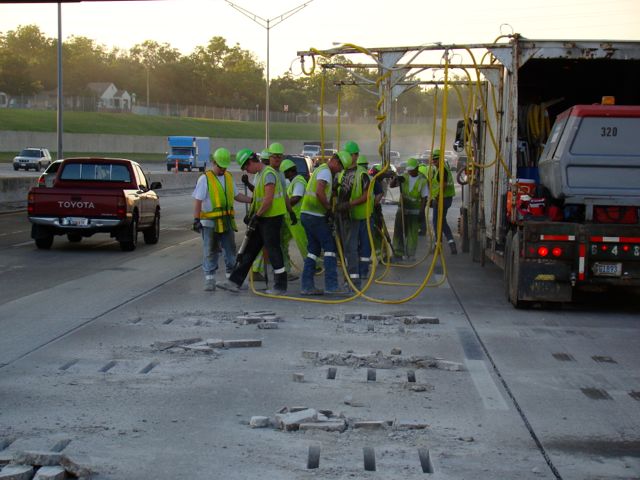 Load Transfer Restoration (Dowel Bar Retrofit)
Load Transfer Restoration (Dowel Bar Retrofit)
What: Mechanical devices (dowel bars) are installed in an existing rigid (Portland Cement Concrete) pavement to restore load transfer. The retrofit begins with cutting of six slots (three in each wheel path) across all transverse joints or cracks. The slots are cut with diamond saws that make six cuts in each wheel path. The concrete between the saw cuts is then removed with lightweight jackhammers (heavy-weight jackhammers tend to damage the concrete around the cuts). The epoxy-coated dowel bars are placed in the slots, then the slots are filled with a quick setting concrete (grout) and the joints or cracks are filled with waterproof caulk. A final step often involves diamond-grinding of the repair site or the entire road surface to remove any bumps or dips and improve smoothness. Without the dowel bar retrofit this grinding would have to be repeated every six to eight years, but it is predicted that the retrofit will greatly decrease the need for regrinding.
Where: The retrofit is appropriate for transverse joints or cracks on PCC pavements (especially JPCP–jointed plain concrete pavements) in good structural condition where there is poor load transfer (<50-60%), differential deflection greater than 0.01”, faulting of 0.12 to 0.5”, and fewer than 10% of the slabs with multiple cracks. It is also appropriate in areas where dowel bars have failed or have been improperly placed.
Why (advantages): Load transfer reduces stresses in the slab and also reduces deflections at the joint. Effective load transfer slows or reduces development of pumping and faulting by reducing slab deflections. It decreases cracking and corner breaks within the slab by reducing tensile stresses. The process improves the long-term rideability and preserves the pavement with an increased service life.
Why not (disadvantages): The process is expensive and may be time-consuming, but allowing the problem to persist will result in poor rideability and premature pavement failure. If the pavement and its structure are in overall poor condition, rehabilitation may be a better option. The process is not appropriate when there is presence of alkali-silica reaction (ASR), alkali-carbonate reaction (ACR), D-cracking or  where extensive amounts of full or partial depth repair are needed.
where extensive amounts of full or partial depth repair are needed.
When: The process should be done after a distress survey and deflection testing showing the indicative criteria listed above. Jointed Plain Concrete Pavements depend on aggregate interlock to transfer load across joints. As these joints deteriorate through age and trafficking, aggregate interlock is lost and load transfer decreases.
Estimated life extension: 2-16 years.
For more information, see FHWA’s Guide for Load Transfer Restoration and the Dowel Bar Retrofit Checklist put together by FHWA and the Foundation for Pavement Preservation.
